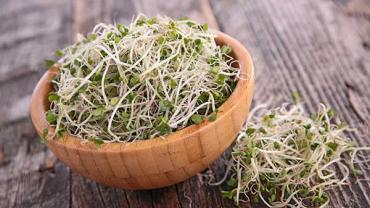
Like all psychiatric disorders, schizophrenia is a debilitating condition that can result in disability, social stigma, and increased risk for early death from physical illnesses. According to the World Health Organization, schizophrenia affects about 21-23 million people worldwide, with more men than women afflicted. Currently available drugs for this condition may come with undesirable side-effects and are not effective for all patients. With that in mind, alternative or adjunct therapies would be most welcome.
New research suggests that sulforaphane, a bioactive compound found in cruciferous vegetables, especially broccoli seeds and sprouts, may be beneficial for altering levels of glutathione and glutamate in the brain, which may have an application in those with schizophrenia. Compared to healthy people, those with psychosis have altered levels of glutamate and glutathione in certain brain regions. Researchers have speculated that glutathione may serve as reservoir or storage pool for glutamate and could have an influence on synaptic excitability. Targeting this could have implications for treating schizophrenia.
In an experiment using rat brain cells, researchers chemically inhibited the incorporation of glutamine into glutathione, and this resulted in nerves being more excitable and firing faster, shifting to a pattern akin to that seen in the brains of people with schizophrenia. Doing the opposite—inhibiting release of glutamate via the glutathione cycle decreased cytosolic glutamate and slowed the firing speed.
Some of the same researchers investigated the potential for sulforaphane to alter glutathione levels in the brains of healthy humans, operating under the possibility that this may have a beneficial application for schizophrenia patients. Subjects (n=9, so a very small study) consumed 100 µmol sulforaphane (as broccoli sprout extract) daily for one week. Blood and urine samples were collected prior to the first dose and within four hours of the final dose. The final measurement indicated that glutathione levels in the brain increased by about 30%. If this was the result of more glutamate being used for the purpose of synthesizing glutathione, it’s possible this could pave the way for further research in using sulforaphane as an addition to other treatments for schizophrenia.
This is all highly preliminary and speculative—there’s no evidence yet that this would be an effective intervention for schizophrenia, but it points to a plausible mechanism that warrants further research in humans afflicted with the condition to determine an optimal effective dose and to ascertain how long treatment would be required before a beneficial effect is seen—if one is seen at all. Certainly, broccoli seed or sprout extract containing sulforaphane has shown promise for other applications, such as fighting head and neck cancer (in animals), potentially slowing progression of prostate cancer, and improving glucose control in patients with type 2 diabetes.
In the meantime, while more research remains to be done, for people looking to try strategies that have shown promise in humans with schizophrenia rather than in already healthy people, or in rat brain cells and petri dishes, dietary interventions may be worth implementing. Evidence suggests that at least in some patients with schizophrenia, the disorder may be a manifestation of gluten intolerance. Gluten intolerance may drive other mental and psychiatric issues as well, to the point that some researchers even coined the phrase “gluten psychosis.” Evidence is mixed on the efficacy of gluten-free diets for improving schizophrenia, however. Some patients show remarkable improvement, while others do not respond to the dietary change.
Ketogenic diets are another approach worth trying. Limited but very encouraging case reports indicate that dietary ketosis can put schizophrenia into apparently complete remission. One such report details the case of a 70-year-old woman who’d lived with visual and auditory hallucinations since the age of 17. She’d been hospitalized at least five times over the prior six years for suicide attempts and increased psychotic symptoms. Her symptoms showed remarkable improvement in a very short time after adopting a ketogenic diet. In a follow-up clinical visit 19 days after initiating the diet, she reported that on the eighth day, she was no longer hearing voices and there was a decrease in visual hallucinations—and this occurred with no change in her medication regimen; the only change was in her diet. Over the course of 12 months, the subject continued the ketogenic diet and had no recurrence of auditory or visual hallucinations, even when there were isolated occurrences of increased carbohydrate intake. Additional positive outcomes from ketogenic diets for schizophrenia have been reported as well.
Ketones and ketogenic diets induce several beneficial molecular changes in the brain and central nervous system that may be responsible for the effects seen in patients with psychiatric disorders. In the specific case of schizophrenia, it’s believed that the influence of ketosis on increasing GABA synthesis and increasing the GABA; glutamate ratio may play a role.